#the nebular theory
Explore tagged Tumblr posts
Note
Heyheyhey! I hope work is treating you well! I was wondering… does forgotten!MC have some time after being remembered in dreams before the person they’re visiting wakes up? I got to thinking about them trying to get a hug from Toriel…. And it hurt a little to think they wouldn’t be able to hug her haha
Hi friend!!! You’re an angel for sending me an ask on the fic I haven’t updated in 84 years!!! I am dying to get back to writing creatively so this is a super fun question to think about!
In Ch 1-2 I kindof allude to the fact that the memory fades Extremely quickly after waking up - imagine it like something the universe must actively shroud or erase. It takes a minute or two for it to happen. Enough time for Sans & Papyrus to make some brief notes about the dream (the pages that Sans skips over because “they aren’t important” are pages where he DID manage to write about Reader specifically but… unfortunately, Void-bound beings have Anti-Existence and any mention of them creates something of a vacuum of existence as well, so all the pages of notes that mention the Reader specifically become ‘voids’ of existence. They exist. But you just can’t be actively aware of them.)
However… in dreams… the rules are a little more fuzzy. In dreams you can think of things that haven’t ever happened and will never happen. Things that don’t currently exist. The universe doesn’t *like* it, per-say, if Anti-Existence things enter your mind while sleeping. But it’s allowed. The sleep is easier to disturb and such.
The main reason MC/Reader doesn’t want Sans to remember them in his dream is that it resets the progress they’ve made towards getting out of the Void because Sans/Papyrus make the connection between “oh all these things I have notes about are actually notes about YOU” … so then when they wake up… now all of those vague notes are connected with an Anti-Existence and so too become a vacuum of noticings. They’ve been doing this for ages and are REALLY trying to escape the Void, and its a huge pain in the butt to have all your progress restarted. There’s always a tearful reunion, of course. Because connecting the things kindof opens the floodgates of memories. But it’s “allowed” in the dream-realm where the rules have always been a little wonky.
What’s-Left-Of-Gaster, though… he has been in the Void long enough to have access to the Base Code. He can give a Command Code that overrides the UTMV ‘must erase/hide the things’ protocol. Which is why everyone can suddenly remember without issue once What’s-Left-Of-Gaster shows up in all his boneless, goopy glory and gives the Command Code.
I hope that helps! Thanks so much for asking! This was fun!!!
6 notes
·
View notes
Text
Thoughts/Comments under the cut
First of all

Second of all
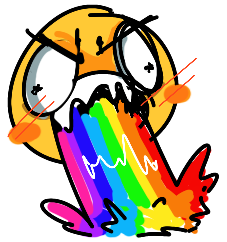
And third:
Djdkdjdbfndbdkfjdnbdkakdjdjejrbfbfkdjiebrbfkfidjebf dndjfijwbfnkdiebjeiduejdb
Ok
For realsies tho
THE SOS IN THE THREAD IM SOBBINGGGGG WHAT DO YOU MEAN THATS THE MOST abdjfjsbfngk SHDUDJIDBDBNF STOOOOP I’m crying that’s the entire first two chapters encapsulated in a single heartbeat I’m in awe I’m touched I’m dying
Also the house. Babe the house. Thank you for keeping the house I love it. Like you could have drawn a new house but seriously I love love love the jpeg house and you made it look so nice THAT FIRE IS SO PRETTY and the PETALS FLOWEYS PETALS AND THE SNAPSHOTS OF SO MANY OTHER LOST MOMENTS ALL BURNING UP IN THIS FIRE THAT STARTED THE REST OF THE RESETS IM INCONSOLABLE and how they just blend so nicely with the stars and it’s like it never happened BUT IT DID AND IT MATTERS AND and and *weeping*
The juxtaposition of the PLEA that he not try to remember it until it was the right time next to this moment of him finally getting to really see the stars A MOMENT HE ULTIMATELY LOSES and we the reader KNOW he loses it because we’re just reading what he eventually remembers BUT IT STILL HAPPENED AND IT MATTERED SO MUCH TO HIMMMMBB
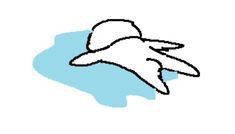
Nobody look at me im sobbing on the floor
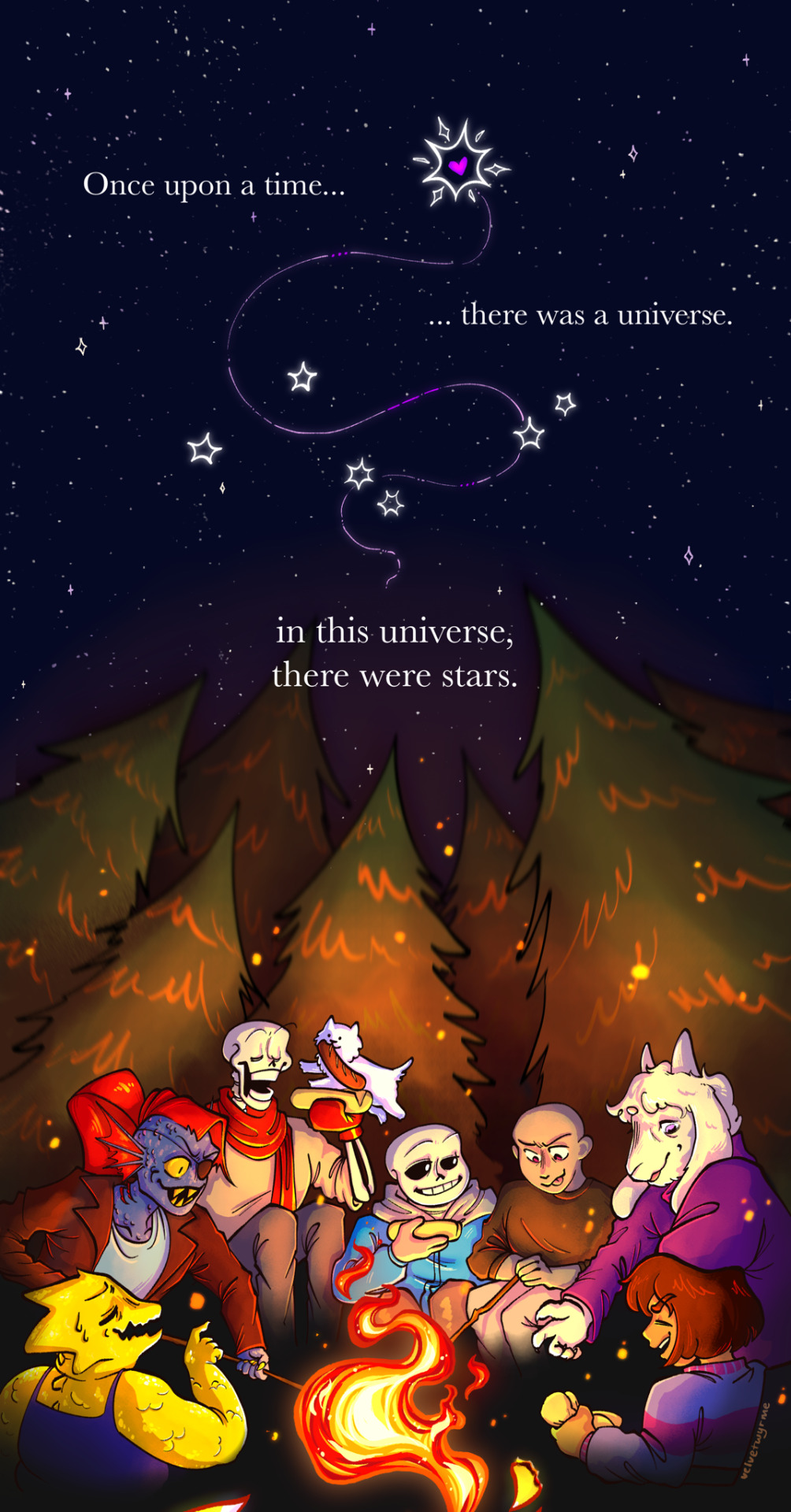
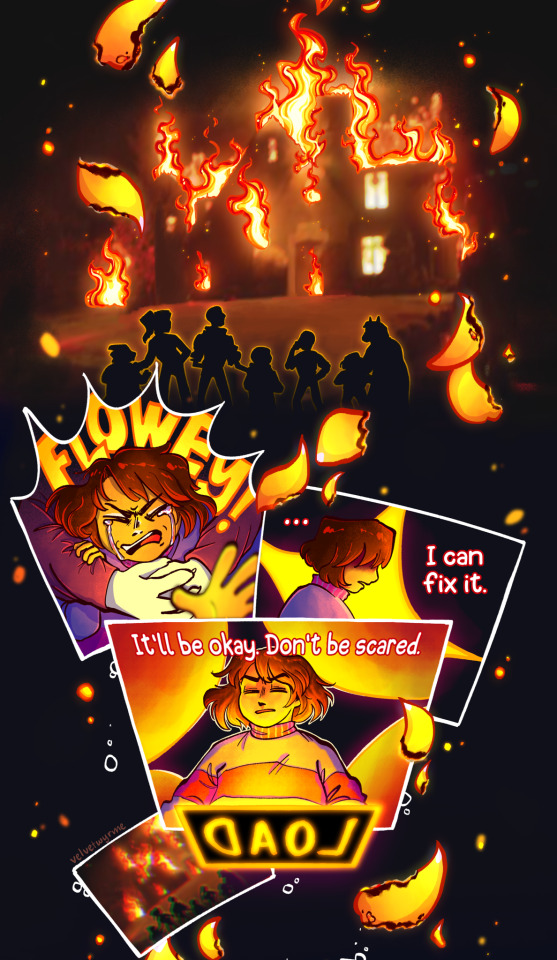
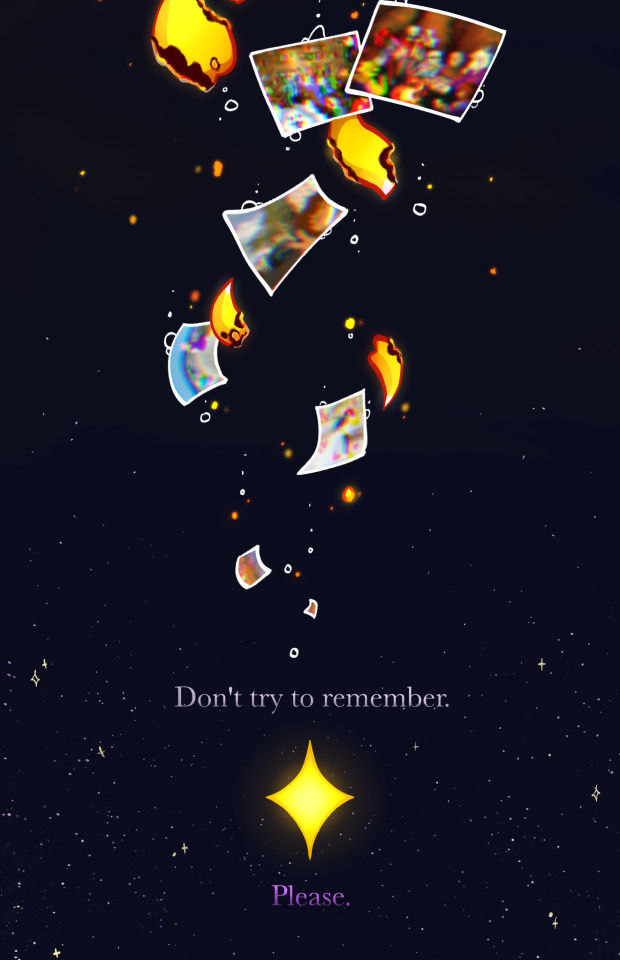

Universe full of Stars // Fanart for The Nebular Theory
Thank you to the wonderful @theundertalenebulartheory for commissioning me!! 💛💛 I love this fic dearly and it was an absolute joy to work on this :>!! (If you haven't read it... go do that!! It's amazing!!!)
Commission Info // Ko-Fi
218 notes
·
View notes
Note
The oldest material found in the Solar System is dated to 4.5682+0.0002
−0.0004 Ga (billion years) ago.[35] By 4.54±0.04 Ga the primordial Earth had formed.[36] The bodies in the Solar System formed and evolved with the Sun. In theory, a solar nebula partitions a volume out of a molecular cloud by gravitational collapse, which begins to spin and flatten into a circumstellar disk, and then the planets grow out of that disk with the Sun. A nebula contains gas, ice grains, and dust (including primordial nuclides). According to nebular theory, planetesimals formed by accretion, with the primordial Earth being estimated as likely taking anywhere from 70 to 100 million years to form.[37]
Estimates of the age of the Moon range from 4.5 Ga to significantly younger.[38] A leading hypothesis is that it was formed by accretion from material loosed from Earth after a Mars-sized object with about 10% of Earth's mass, named Theia, collided with Earth.[39] It hit Earth with a glancing blow and some of its mass merged with Earth.[40][41] Between approximately 4.1 and 3.8 Ga, numerous asteroid impacts during the Late Heavy Bombardment caused significant changes to the greater surface environment of the Moon and, by inference, to that of Earth.[42]
Earth's atmosphere and oceans were formed by volcanic activity and outgassing.[43] Water vapor from these sources condensed into the oceans, augmented by water and ice from asteroids, protoplanets, and comets.[44] Sufficient water to fill the oceans may have been on Earth since it formed.[45] In this model, atmospheric greenhouse gases kept the oceans from freezing when the newly forming Sun had only 70% of its current luminosity.[46] By 3.5 Ga, Earth's magnetic field was established, which helped prevent the atmosphere from being stripped away by the solar wind.[47]
As the molten outer layer of Earth cooled it formed the first solid crust, which is thought to have been mafic in composition. The first continental crust, which was more felsic in composition, formed by the partial melting of this mafic crust.[49] The presence of grains of the mineral zircon of Hadean age in Eoarchean sedimentary rocks suggests that at least some felsic crust existed as early as 4.4 Ga, only 140 Ma after Earth's formation.[50] There are two main models of how this initial small volume of continental crust evolved to reach its current abundance:[51] (1) a relatively steady growth up to the present day,[52] which is supported by the radiometric dating of continental crust globally and (2) an initial rapid growth in the volume of continental crust during the Archean, forming the bulk of the continental crust that now exists,[53][54] which is supported by isotopic evidence from hafnium in zircons and neodymium in sedimentary rocks. The two models and the data that support them can be reconciled by large-scale recycling of the continental crust, particularly during the early stages of Earth's history.[55]
New continental crust forms as a result of plate tectonics, a process ultimately driven by the continuous loss of heat from Earth's interior. Over the period of hundreds of millions of years, tectonic forces have caused areas of continental crust to group together to form supercontinents that have subsequently broken apart. At approximately 750 Ma, one of the earliest known supercontinents, Rodinia, began to break apart. The continents later recombined to form Pannotia at 600–540 Ma, then finally Pangaea, which also began to break apart at 180 Ma.[56]
The most recent pattern of ice ages began about 40 Ma,[57] and then intensified during the Pleistocene about 3 Ma.[58] High- and middle-latitude regions have since undergone repeated cycles of glaciation and thaw, repeating about every 21,000, 41,000 and 100,000 years.[59] The Last Glacial Period, colloquially called the "last ice age", covered large parts of the continents, to the middle latitudes, in ice and ended about 11,700 years ago.[60]
Chemical reactions led to the first self-replicating molecules about four billion years ago. A half billion years later, the last common ancestor of all current life arose.[61] The evolution of photosynthesis allowed the Sun's energy to be harvested directly by life forms. The resultant molecular oxygen (O2) accumulated in the atmosphere and due to interaction with ultraviolet solar radiation, formed a protective ozone layer (O3) in the upper atmosphere.[62] The incorporation of smaller cells within larger ones resulted in the development of complex cells called eukaryotes.[63] True multicellular organisms formed as cells within colonies became increasingly specialized. Aided by the absorption of harmful ultraviolet radiation by the ozone layer, life colonized Earth's surface.[64] Among the earliest fossil evidence for life is microbial mat fossils found in 3.48 billion-year-old sandstone in Western Australia,[65] biogenic graphite found in 3.7 billion-year-old metasedimentary rocks in Western Greenland,[66] and remains of biotic material found in 4.1 billion-year-old rocks in Western Australia.[67][68] The earliest direct evidence of life on Earth is contained in 3.45 billion-year-old Australian rocks showing fossils of microorganisms.[69][70]
During the Neoproterozoic, 1000 to 539 Ma, much of Earth might have been covered in ice. This hypothesis has been termed "Snowball Earth", and it is of particular interest because it preceded the Cambrian explosion, when multicellular life forms significantly increased in complexity.[72][73] Following the Cambrian explosion, 535 Ma, there have been at least five major mass extinctions and many minor ones.[74] Apart from the proposed current Holocene extinction event, the most recent was 66 Ma, when an asteroid impact triggered the extinction of non-avian dinosaurs and other large reptiles, but largely spared small animals such as insects, mammals, lizards and birds. Mammalian life has diversified over the past 66 Mys, and several million years ago, an African ape species gained the ability to stand upright.[75][76] This facilitated tool use and encouraged communication that provided the nutrition and stimulation needed for a larger brain, which led to the evolution of humans. The development of agriculture, and then civilization, led to humans having an influence on Earth and the nature and quantity of other life forms that continues to this day.[77]
YESSSS, FEED ME KNOWLEDGE
(Did you copy and paste from Wikipedia)
(And I’m also writing this in school😈)
2 notes
·
View notes
Text
idk what my prime directive is, but i know I failed in it... which should mean i get to do whatever i want to but i feel... where was i reading this something along the lines of "i need to make up for the fact it's me"
nebular theory an undertale fanfiction. thats it i bet
but yeah i just. feel like ive failed. in basic shit. and I'm losing shit im never going to get back and I'm going to end up alone. not in a romantic sense.
idk look upon my works ye mighty and despair yanno? only on a smaller scale. the value of my life to myself and those i care about.
2 notes
·
View notes
Text
0 notes
Text
5 things that link to my chosen specialist pathway
Planets-
A planet is a large, roundedastronomical body that is generally required to be in orbit around a star, stellar remnant, or brown dwarf, and is not one itself. The Solar System has eight planets by the most restrictive definition of the term: the terrestrial planetsMercury, Venus, Earth, and Mars, and the giant planetsJupiter, Saturn, Uranus, and Neptune. The best available theory of planet formation is the nebular hypothesis, which posits that an interstellar cloud collapses out of a nebula to create a young protostar orbited by a protoplanetary disk. Planets grow in this disk by the gradual accumulation of material driven by gravity, a process called accretion.
asteroids-
An asteroid is a minor planet, an object larger than a meteoroid that is neither a planet nor an identified comet that orbits within the inner Solar System or is co-orbital with Jupiter . Asteroids are rocky, metallic, or icy bodies with no atmosphere, and are broadly classified into C-type, M-type, or S-type. The size and shape of asteroids vary significantly, ranging from small rubble piles under a kilometer across to Ceres, a dwarf planet almost 1000 km in diameter.
Space vehicle-
A space vehicle is the combination of a spacecraft and its launch vehicle which carries it into space. The earliest space vehicles were expendable launch systems, using a single or multistage rocket to carry a relatively small spacecraft in proportion to the total vehicle size and mass. An early exception to this, the Space Shuttle, consisted of a reusable orbital vehicle carrying crew and payload, supported by an expendable external propellant tank and two reusable solid-fuel booster rockets.
Reusable launch systems are currently being developed by private industry.
area 51-
The intense secrecy surrounding the base has made it the frequent subject of conspiracy theories and a central component of unidentified flying object (UFO) folklore. It has never been declared a secret base, but all research and occurrences in Area 51 are Top Secret/Sensitive Compartmented Information.
Some claim that the site hosts an alien spacecraft and the bodies of its pilots, after they crashed at Roswell, New Mexico, in 1947.
Others claim to have seen UFOs above or near the site, while some say they have been abducted by aliens, and even experimented on, before being returned to Earth.
In 1989, a man named Robert Lazar claimed he had worked on alien technology inside Area 51. He claimed to have seen medical photographs of aliens and that the government used the facility to examine UFOs.
stars-
A star is a luminous spheroid of plasma held together by self-gravity. The nearest star to Earth is the Sun. Many other stars are visible to the naked eye at night; their immense distances from Earth make them appear as fixed points of light. The most prominent stars have been categorised into constellations and asterisms, and many of the brightest stars have proper names. Astronomers have assembled star catalogues that identify the known stars and provide standardized stellar designations.
0 notes
Text
Who Invented the Solar System and When?
New Post has been published on https://wr1tepress.com/who-invented-the-solar-system-and-when-4/
Who Invented the Solar System and When?
In a universe teeming with cosmic wonders, the question of who exactly invented the solar system and when it came into being remains a tantalizing enigma. As you gaze up at the night sky, its celestial bodies shimmering with ancient stories, you can't help but wonder about the origins of our own planetary home.
Delve into the annals of history and scientific inquiry, and you'll uncover a fascinating journey of human curiosity, observation, and discovery. From the ancient cosmological beliefs that shaped early civilizations to the modern understanding of solar system formation, the quest to unveil the mysteries of our cosmic neighborhood has yielded significant breakthroughs, yet leaves us with countless unanswered questions.
So, buckle up and prepare to embark on a captivating exploration of the birth of the solar system and the cosmic forces that brought it into existence.
Key Takeaways
Ancient civilizations, such as the Egyptians, Greeks, and Chinese, had different cosmological beliefs that shaped their understanding of the solar system.
Nicolaus Copernicus proposed the heliocentric model, placing the sun at the center of the solar system, challenging the geocentric model.
Early observations and theories by Copernicus, Kepler, and Galileo laid the foundation for our modern understanding of the solar system.
The modern understanding of solar system formation is based on the Nebular Hypothesis, which suggests that our solar system formed from a collapsing giant molecular cloud called a nebula.
Ancient Cosmological Beliefs
Ancient civilizations held diverse and intriguing cosmological beliefs, shaping their understanding of the solar system. As a member of a community seeking belonging, it's fascinating to explore how these ancient cultures perceived the cosmos.
The Egyptians, for example, believed that the sun god Ra sailed across the sky during the day and traveled through the underworld at night. They associated the movements of the sun with life and death, emphasizing the cyclical nature of existence.
In contrast, the ancient Greeks believed that the earth was the center of the universe and that the sun, moon, and planets revolved around it. This geocentric model, proposed by philosophers like Aristotle and Ptolemy, was widely accepted for centuries.
The ancient Chinese, on the other hand, viewed the cosmos as a harmonious balance between yin and yang, with celestial bodies representing various forces and energies. Their belief in the interconnectedness of everything in the universe fostered a sense of belonging and unity with the cosmos.
These diverse cosmological beliefs influenced the way ancient civilizations interacted with the solar system, shaping their understanding of the heavens and their place within it.
Early Observations and Theories
As you explore the early observations and theories of the solar system, you'll uncover the fascinating discoveries made by astronomers throughout history. These early astronomers, driven by a deep curiosity about the world and their place in it, made significant contributions to our understanding of the solar system.
One of the earliest recorded observations of the solar system was made by the ancient Greeks. They believed that the Earth was at the center of the universe and that the other celestial bodies, including the sun, moon, and planets, revolved around it. This geocentric model, as it came to be known, was widely accepted for centuries.
However, as more accurate observations were made and new theories developed, this geocentric model was challenged. In the 16th century, Nicolaus Copernicus proposed a heliocentric model, which placed the sun at the center of the solar system. This groundbreaking theory was later supported by the observations and mathematical calculations of Johannes Kepler and Galileo Galilei.
These early observations and theories laid the groundwork for our modern understanding of the solar system. They sparked further exploration and inspired generations of astronomers to come. By studying their discoveries, we can gain a sense of connection to these early pioneers and the collective human effort to unravel the mysteries of the universe.
The Modern Understanding of Solar System Formation
Scientists have developed a modern understanding of solar system formation based on extensive research and evidence. Here is what we know:
The Nebular Hypothesis: Scientists believe that our solar system formed from a giant molecular cloud called a nebula. This cloud consisted of gas and dust, which began to collapse under its own gravity. As it collapsed, it started spinning faster, forming a spinning disk shape. The center of the disk eventually became our Sun, while the remaining material formed the planets, moons, and other celestial bodies.
Accretion: Within the spinning disk, small particles of dust and gas collided and stuck together, forming larger objects called planetesimals. Over time, these planetesimals continued to collide and grow, eventually becoming planets. The process of accretion played a crucial role in the formation of our solar system.
Late Heavy Bombardment: After the planets formed, the solar system experienced a period of intense bombardment known as the Late Heavy Bombardment. During this time, leftover planetesimals and other debris from the formation process bombarded the planets, causing significant cratering and shaping their surfaces.
Understanding the formation of our solar system provides a sense of belonging and connection to the universe. It allows us to appreciate the intricate processes that led to the creation of our home in space.
Significant Discoveries and Breakthroughs
Throughout history, numerous groundbreaking discoveries and breakthroughs have revolutionized our understanding of the solar system. These significant advancements have provided us with a sense of belonging, as we continue to unravel the mysteries of our cosmic neighborhood.
One of the most significant discoveries was made by Nicolaus Copernicus in the 16th century. He proposed the heliocentric model, which suggested that the Sun, rather than the Earth, was at the center of the solar system. This revolutionary idea challenged the prevailing belief of geocentrism and paved the way for further scientific exploration.
In the 17th century, Galileo Galilei made crucial observations using his newly invented telescope. He discovered four of Jupiter's moons, providing evidence that celestial bodies could orbit something other than Earth. Galileo's observations supported Copernicus' heliocentric model and expanded our understanding of the solar system.
In the 18th and 19th centuries, astronomers like William Herschel and Johannes Kepler made significant breakthroughs in understanding planetary motion and the formation of the solar system. Herschel discovered Uranus, while Kepler's laws of planetary motion laid the foundation for our understanding of how planets orbit the Sun.
In the 20th century, breakthroughs in space exploration allowed us to witness the solar system like never before. The Voyager missions provided stunning images and data about the outer planets, while the Hubble Space Telescope revealed the vastness and beauty of the cosmos.
These significant discoveries and breakthroughs have shaped our understanding of the solar system, fostering a sense of belonging as we explore the wonders of our celestial neighborhood.
Unanswered Questions and Future Research Directions
After exploring the significant discoveries and breakthroughs that have revolutionized our understanding of the solar system, it's now time to address the unanswered questions and future research directions that lie ahead. As members of a society that seeks belonging and desires to unravel the mysteries of our cosmic neighborhood, we find ourselves eager to delve deeper into the unknown.
Here are three key areas that remain open for exploration:
Origins of the Solar System: Despite our progress, the precise mechanisms that led to the formation of the solar system still elude us. Scientists continue to investigate the role of protoplanetary disks, the influence of stellar nurseries, and the formation of planetary embryos. By studying these processes, we hope to gain a clearer understanding of how our own solar system came into existence.
Search for Extraterrestrial Life: The quest for extraterrestrial life has captivated our imaginations for centuries. While we've made strides in identifying habitable environments and detecting potential biosignatures, we've yet to find conclusive evidence of life beyond Earth. Future research will focus on exploring promising candidates, such as Mars, Europa, and Enceladus, as well as developing more advanced techniques for detecting signs of life.
Understanding Planetary Dynamics: The dynamics of our solar system, including the movements of planets, asteroids, and comets, remain a fascinating field of study. Unanswered questions persist regarding the evolution of planetary orbits, the origins of asteroid belts, and the mechanisms behind planetary migrations. Ongoing research aims to unravel these mysteries and further our understanding of the intricate dance of celestial bodies.
As we continue to explore the solar system, our collective pursuit of knowledge and our desire for a sense of belonging propel us forward. With each unanswered question, we're driven to push the boundaries of our understanding, ultimately bringing us closer to unraveling the secrets of our cosmic home.
Frequently Asked Questions
How Did Ancient Civilizations Explain the Movement of the Planets in the Solar System?
Ancient civilizations explained the movement of the planets in the solar system by attributing it to the gods. They believed that the gods controlled the celestial bodies and used them to communicate with humanity.
What Were Some of the Early Theories on the Formation of the Solar System?
Imagine a time when scholars pondered the birth of our solar system. They proposed theories, suggesting it formed from a swirling cloud of gas and dust. These early ideas laid the foundation for our understanding today.
How Has Our Understanding of the Solar System Formation Evolved Over Time?
Over time, your understanding of solar system formation has evolved. Scientists have developed theories based on evidence, such as the nebular hypothesis, which suggests that the solar system formed from a giant cloud of gas and dust.
What Are Some Significant Discoveries That Have Contributed to Our Current Understanding of the Solar System?
Some significant discoveries that have contributed to our current understanding of the solar system include the detection of exoplanets, the discovery of water on Mars, and the exploration of Saturn's moon, Enceladus.
What Are the Current Unanswered Questions in Solar System Research and What Are the Future Research Directions in This Field?
What are the current unanswered questions in solar system research and what are the future research directions in this field? Well, there's still so much we don't know. Scientists are eager to explore new planets, understand the origins of life, and unravel the mysteries of dark matter. Exciting times ahead!
Conclusion
You've journeyed through the vast expanse of time and knowledge, exploring the origins of our solar system. Like a cosmic dance, ancient beliefs, early observations, and modern understanding have woven together to unravel its mysteries.
But even with significant discoveries and breakthroughs, there are still unanswered questions that beckon future research.
The solar system, like a dazzling tapestry, continues to captivate and inspire our imagination, reminding us of the wonders that await us in the boundless reaches of the universe.
0 notes
Link
In a surprising find, the international ALMA Survey of Orion Planck Galactic Cold Clumps (ALMASOP) team recently observed a young quadruple star system within a star-forming region in the Orion constellation. The discovery was made during a high-resolution survey of 72 dense cores in the Orion Giant Molecular Clouds (GMCs) using the Atacama Large Millimeter/submillimeter Array (ALMA) in Chile. These observations provide a compelling explanation for the origins and formation mechanisms of binary and multiple-star systems. The team was led by Prof. Liu Tie from the Shanghai Astronomical Observatory (CAS-SHAO). He was joined by researchers from the CAS-SHAO, the School of Astronomy and Space Science (CAS-SASS), the NRC Herzberg Astronomy and Astrophysics, the National Astronomical Observatory of Japan (NAOJ), the Max Planck Institute for Astronomy (MPIA), the Korea Astronomy and Space Science Institute (KASI), Academia Sinica Institute of Astronomy and Astrophysics (ASIAA), the NSF NOIRLab’s International Gemini Observatory, the Armagh Observatory and Planetarium, NASA’s Jet Propulsion Laboratory, and multiple universities and institutes. ALMA observations of the star-forming region G206.93-16.61E2, showing the 1.3mm emissions (blue) and the CO molecular outflow (orange). Credit: SHAO/Qiuyi Luo et al. (2023) It’s a well-known fact among astronomers and astrophysicists that roughly half of the stars in the Milky Way reside in binary systems. Knowing how multiple star systems form is essential to understanding galactic evolution, planetary formation, and the emergence of life. The most widely accepted theory regarding star formation (the Nebular Hypothesis) states that stars form in the densest regions of molecular clouds (aka. “dense core”). While this theory accounts for individual star systems very well, the mechanisms that drive the formation of multi-star systems are not yet well understood. It is currently thought that multiple star systems form via the fragmentation of cloud cores during their early evolution, but observations are historically lacking. To investigate this mystery, the ALMASOP team examined 72 young and cold cores in the GMCs in the Orion constellation for thermal emissions corresponding to a wavelength of 1.3 mm – in the extremely high frequency (EHF) range. When observing a dense cold core in Orion B GMC about 1,500 light-years from Earth (designated G206.93-16.61E2), they observed a system of four stellar objects. These consisted of two protostars and two gas concentrations that are likely to undergo gravitational collapse in the near future. They further observed that the largest separation between the four objects in the system was about 1,000 Astronomical Units (AUs), over 33 times the distance between the Sun and Neptune (30 AUs). This stands in contrast to the last time a quadruple system was observed in 2015 by another international team using ALMA. In that case, the discovery team observed a young protostar and three gravitationally-bound dense gas clouds that would form new stars in ~40,000 years. In that case, however, the quadruple system observed had a wide separation far greater than 1,000 Astronomical Units (AUs). The dust emission spectra also revealed several elongated ribbon-like structures that bound the four objects together and extended outwards. To determine the role played by these structures, the team conducted a numerical simulation that compared a similar quadruple system to the one they observed. Based on the results, the team theorizes that these extended ribbons could be “funnels” that transport gas from the core’s outer envelope to the protesters and connect newborn stars. G205.46-14.56 clump located in Orion molecular cloud complex. The yellow contours represent the dense cores discovered by the JCMT, and the zoomed-in pictures show the 1.3mm continuum emission of ALMA observation. Credit: Qiuyi Luo et al. (2022). Said Luo Qiu-yi, a Ph.D. student at SHAO and the first author of the study: “The exceptional compactness and close-proximity of this system is a fascinating discovery. The analysis suggests that this system is very likely to form a gravitationally bound quadruple star system in the future. We do not have an explanation that how the gas outflows propagate as they might be entangled with gas accretion processes of system members. This study highlights the complicated interactions among members in a forming higher-order star system.” “The simulation supports that these ribbons can serve as large-scale accretion streamers,” added Prof. Liu. “Thus, the two gas condensations in the system have the potential to form a star relying on the feeding of these continuum ribbons. The accretion streamers could also fragment, and further form new stars.” Last, the observations revealed intricate gas outflows caused by the stellar winds generated by the protostars in the system, causing some of the accreting gas and dust to be lost. Similar to what has been observed around Active Galactic Nuclei (AGNs), where winds generated by the Supermassive Black Hole (SMBH) push material out of the galactic center, this could impact the evolution of this system. Future observations using ALMA and other millimeter/submillimeter observatories, scientists hope to reveal more details about multi-star systems in the formation process. Further Reading: Chinese Academy of Sciences The post Astronomers Find a Newly-Forming Quadruple-Star System appeared first on Universe Today.
0 notes
Text

No, that one actually is wrong. Solar system collision theory was the idea that all the planets were formed when the sun was hit by another star, ejecting large blobs of matter that became planets. The actual prevailing theory for how the solar system formed these days is the nebular hypothesis.
I love old science books so much


This was from 1963
295 notes
·
View notes
Note
for the wip ask game! im dyyying to ask about The Nebular Theory but ... 👀👀👀 Spontaneous Generation??? I love finding out more abt stories i havent heard of yet...
- velvetwyrme
Abdjdhdjdjs
Lmfao ok ok Spontaneous Generation is 100% a self indulgent Holy Shit Two Cakes take on this Living Doll AU for FNAF Sun and Moon wholesale snatched from As Long As We Are Loved on AO3
https://archiveofourown.org/works/54656689
Like… yes FNAF Sun and Moon 👀 but THE WORLDBUILDING THE MAGIC SYSTEM THE REALISTIC LIMITATIONS THE EVERYTHING OUGH
So me being an incorrigible Simp For Compelling Narratives wanted to dream up a slightly different take on the story. Story Spoilers for the AO3 fic under the cut in case anyone wants to go read the story online first before seeing anything more
So in like Chapter 2 or 3 Sun and Moon are abandoned by Their Person and Reader picks them up from the park where they were abandoned. It’s a real gut punch of course and it get WORSE when it’s revisited later BUT one key part of the gutpunch is that they were in this part full of people and nobody stopped to help for DAYS.
So like… yes this tidbit does fit into the worldbuilding for this story where most people view living dolls like a pet you can talk to (vaguely parrot-like in terms of societal weight and protections and respect etc)
But…
Also like…
If most people spotted a random pet/parrot in the park I think it’s likely Someone would stop and help. So I wanted to grab that and run with THAT what-if idea - what if someone DID stop and took them to a rescue center instead?
So then like … 👉🏼👈🏼 ofc since its my self indulgent fic and I can do what I want then the Rescue Center Lady is now the ‘Reader’ who bonds with the abandoned Sun and Moon and really tbh I cannot recommend the OG fic enough it’s heartbreaking and adorable and SO well done it has my heart in stitches fr
I can post a snippet of what I’ve written so far but the best thing I can do FIRST is give that fic rec lol
7 notes
·
View notes
Text

In most versions of the Sophia mythos the fall of the Goddess is intimately linked to the activity of another Aeon, Christos, also named for its flow-signature, "anointing power." In cosmic terms anointing is the capacity of an Aeon to morph from a porous, foamlike state into a fluidic, dewlike state. Foam is not dew, but imagine foam turning to dew. That is anointing in the Pleromic domain. The product of anointing, chrism, is the love sweat of the gods. In the ecstasy of their dancing the Aeons break into a fragrant sweat, a bright, dewy eruption. This is anointing at the cosmic level.

Astrophysicists now accept the presence of "molecular dew" in the galactic arms though not yet at the galactic core, and they are reticent to assume it can have biological properties. Theorists of steady-state plasma cosmology may be approaching a recognition of the foamlike, high-density, low-mass porosity of Aeonic currents. Plasma cosmology is currently the best alternative to the big bang fantasia. In Tantric and Gnostic cosmology alike there is far more foreplay than hard-core, orgasmic sex. This certainly applies to the orgiastic cavorting of the Aeons in the Pleroma.

The hieros gamos (sacred mating) of Sophia and Christos in the core region of our galaxy signals the opening event of the Sophia mythos. Between them they shape or configure the singularity offered by the Originator. The Greek word anthropos means "humanity," or more precisely, "the human template." Anthropos is gender-neutral, distinct from the gender-specific words andros, "male" and gyne, "female." Anthropos is the Gnostic name for the cosmic matrix of the human species, the preterrestrial human genome. The Sophia mythos assumes a version of "directed panspermia," the theory introduced by Nobel Prize-winning Swedish chemist Svante Arrhenius around 1900 and accepted, in various forms, by astronomer Fred Hoyle, Nobel biologist Francis Crick (codiscoverer with James Watson of the structure of DNA), Lynn Margulis, and many other leading minds of our time.
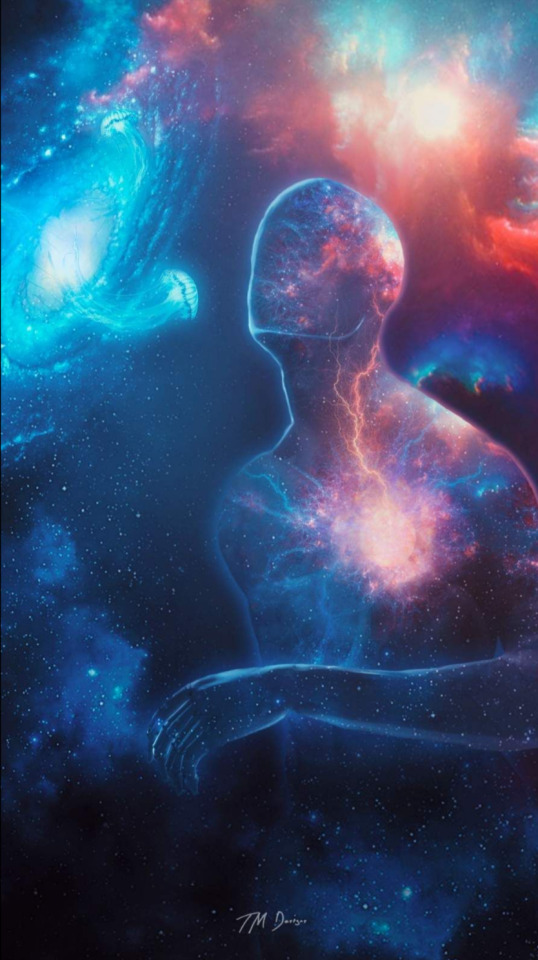
Coming together to encode or configure the Anthropos, Sophia and Christos act in a manner consistent with cosmic law, "for it is the will of the Originator not to allow anything to happen in the Pleroma apart from a syzygy" (A Valentinian Exposition 36.25-30). Syzygy is an odd Greek word used by astronomers to denote the conjunction of celestial bodies. The Originator wills that all activity in the Pleroma be accomplished by paired Aeons, coupled gods, but this is not a rigid rule, and it is not enforced. In the case of the Sophia-Christos syzygy that encodes the Anthropos, the will of the Originator is observed. Once it has been configured by the ritual dance of the coupled Aeons, the singulariry is ready to be projected into manifestation in the cosmos at large.
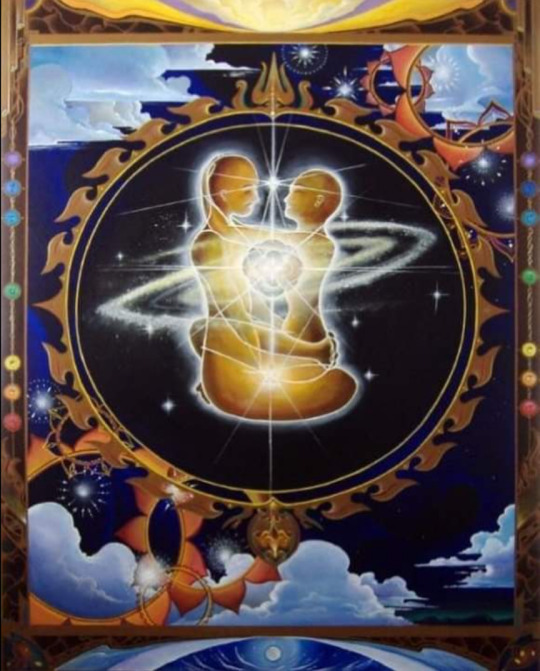
What next occurs in the Pleroma is a collective act, the collaboration of all the Aeons, not just Sophia and Christos acting as a distinct pair. In episode 3, the entire company of Pleromic gods unites in a choral dance to project the encoded singularity into manifesration. They seed it in the outer cosmos, the galactic limbs turning like a vast carousel around the Pleromic hub. The singularity nests in a nebular cloud. Although the language here is mythic, or mythopoetic, the description can be read as applying to the inner dynamics of the Galaxy. The myth clearly suggests astrophysical processes yet unknown ro science, but perhaps beginning to be glimpsed in plasma physics, complexity theory, and the new vision of emergence.
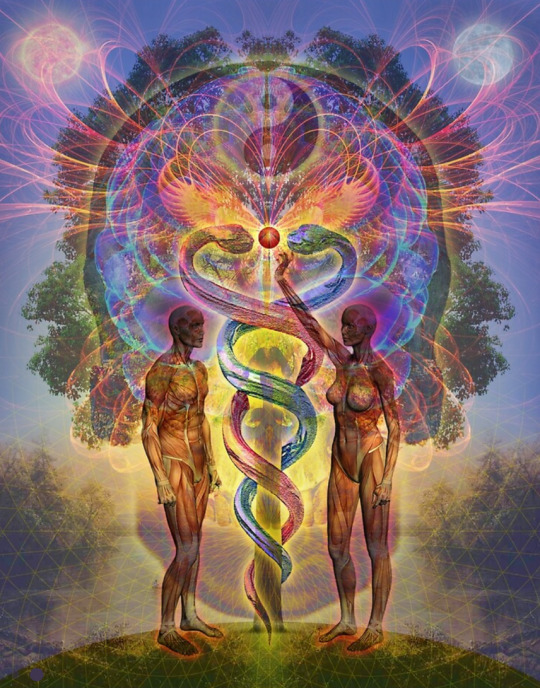
Pleroma means "fullness," "plenum," "plenitude." The galactic vortices are all variations of a chalice form, a flattened torus with a central core (the galactic bulge) and a surrounding disc (the spiral arms). The hub of a galaxy, its Pleroma, is counterbalanced by the flat carousel structure, the spinning armature, called the Kenoma, "deficiency," "formless realm." The Pleroma is a fullness, infinite potential that outpours itself into the realm of "deficiency," finite potential. In the Pleroma all possibility is complete, all is fulfilled, evolved ro its fullest potential. Pleromic gods like Sophia can only give of themselves, selflessly, without affecting what they emanate or imposing themselves upon the conditions they set up in the Kenoma. The selfless outpouring of the Pleromic gods is a key theme of Sophianic cosmology. It is also the model of human generosity.
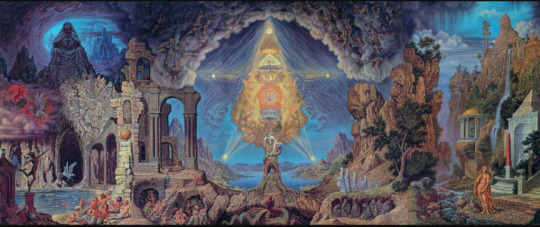
The Kenoma, the carousel armature of a galaxy, is the realm of chaos where finite, bounded potential develops. It is composed of dark elementary matter arrays (dema), atomic and subatomic fields, including organic elements, grains or spores of life. Suns are born in the galactic arms and planetary systems emerge there. On some of the planets organic life unfolds, but the origin of life cannot, it seems, be located on the planet where it arises. Nobel laureare Francis Crick, one of the discoverers of the structure of DNA, argues that, owing to its overwhelming complexity, life on Earth must have been seeded from elsewhere in the cosmos. Lynn Margulis, coauthor of the Gaia hypothesis, also accepts the possibility that microscopic life-forms (propagules) can migrate freely through interstellar space. The universe is a dusty place, and some of the dust is organic residue. That emergent life on planets in the carousel arms of a galaxy originates in the center of the galaxy, as described in episode 3, is not yet recognized by science. This theory will be unacceptable as long as scientists cannot imagine that the core of a galaxy is a vortex of superorganic forces, alive and aware, but this is the Gnostic vision of the Pleromas.
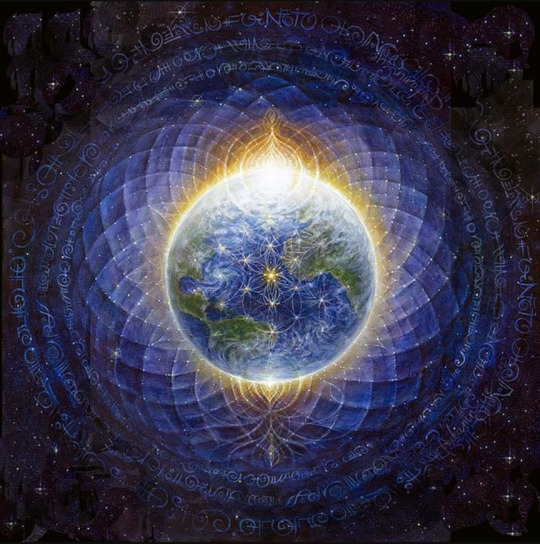
In Tantric cosmology, the composition of the Kenoma is called adrista, "residue." It is, as science tells us, stardust that remains from previous cycles of evolution, cycles without a beginning or end.
"Now the Eternity (which is absolute Truth) has no shadow outside it, for it is a limitless light where all is within and nothing is without. But at its exterior is shadow, which has been called darkness. From the darkness arises a force without form. This is the shadow realm of limitless chaos. From this realm, every kind of divine emanation emerges, including the world we inhabit, for whatever happens in chaos is previously implanted there by what produces it" (On the Origin of the World 98.20-30).
Here the language of the Mystery experience plays into the cosmological scenario. The galactic core is a spinning vortex of Organic Light, a radiant substance that might be compared to soft, luminous nougat. It casts no shadow. Darkness belongs to the exterior regions of the galactic mill wheel, the Kenoma. The residue of previous worlds is continually recycled and reprocessed in the massive armature of the spinning carousel. Whatever develops in the Kenoma was implanted there by Pleromic emanation-including humanity itself, or various strains of humanity, and other species.
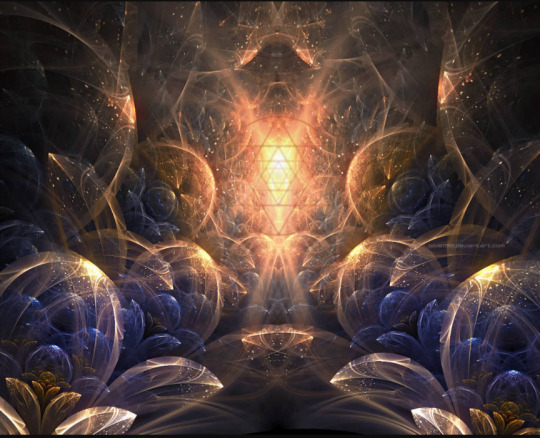
A striking parallel to the stalk of light in the Gnostic narrative occurs in the Japanese myth of creation where paired sky gods, or Kami, project a "Jewel-Sky-Spear" from the cosmic center into the waters of primordial chaos.' The image of cosmic fertilization in the galactic limbs occurs in Egyptian mythology where the sky goddess Nut, curved into an oval, carries the constellations of the zodiac encoded on her body. Cosmic embryonic imagery occurs in almost all high-culture cosmologies and universally in indigenous or "primitive" lore.

The text called On the Origin of the World (NHC II, 5) describes the boundary of the Pleromic core, called menix, hymen, stauros, or horos. Remaining in the core, Aeons can emanate into the arms, the realm of formless chaos, but they do not pass over into those regions. The opalescent stalk of light projected by the collectivity of Aeons may be compared to a klieg light shining through the wall of a white canvas tent. The beam of light passes through the walls, but the source of the beam remains inside the tent. Gnostics texts explain that these two primary conditions, Aeonic pairing and bounded emanation, are set by the Originator. They are cosmic laws but they are not enforced, so exceptions are possible.
Sophia is one of those exceptions.
#anthropos#gnosis#gnosticteachings#cosmology#johnlash#sophia#christos#aeon#plasmaphysics#magnetism#electricity#naghammadi#thegnostics#originstory#hierosgamos#divineunion#sacredmatrimony#sacredmarriage#divinefeminine#sacredmasculine#pleroma
21 notes
·
View notes
Text
AHA NOW I CAN REBLOG FROM THE SOURCE AND MAKE SURE EVERYBODY KNOWS WHERE TO FINDS U
MWAHAHAHAHA!!!

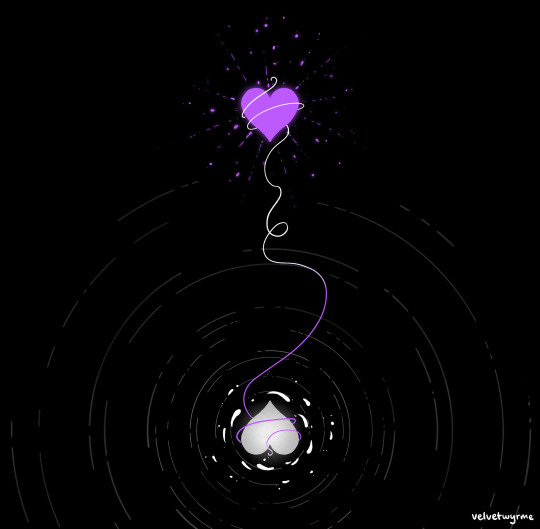

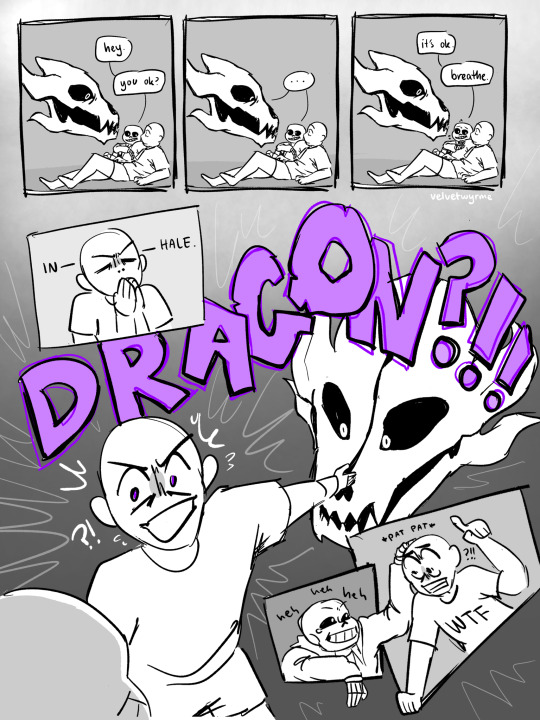
DOG DRAGON?! // The Nebular Theory: Chapter 16
A sketchy comic for The Nebular Theory (@theundertalenebulartheory) which has been dominating my thoughts for the last while!!!
Please please PLEASE go read this fic. It's absolutely amazing and delves into some REALLY COOL exploration of timeline shenanigans and has a hella neat way of visualising that!!
I could sit and spout praises about this fic for hours but honestly just go read it, it's SO good.
343 notes
·
View notes
Text
Dark matter matters
This is a classroom for the coolest school subject ever! Here you will learn about the biggest explosions, cool nebulars, dark matter and on which planet it’s raining diamonds. With your classmates you can create the wildest theories about wormholes. What are you waiting for? Take a seat! The shell was created by Simooligan for the Simooli school collab…
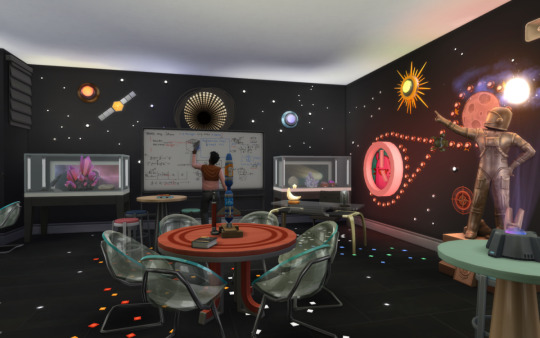
View On WordPress
12 notes
·
View notes
Photo

Electric Rings What force created and sustains Saturn’s rings? Saturn’s main rings, including gaps, are approximately 416,000 kilometers wide, but are estimated to be a mere 50 meters thick, possibly as little as 10 meters. This means that even the most powerful Earth-based telescopes can detect only a thin wire extending across the planetary disk when they are edge-on. Every fourteen or fifteen years, Saturn’s rings become invisible to telescopes on Earth. That equinox passed in August of 2009, so the rings are now shifted to the north. The reason for the ring tilt is that Saturn, itself, is tilted on its axis by 27.4 degrees. Since the rings are tilted at the same angle, as Saturn revolves around the Sun in its 30 year orbit, it gradually brings them into visual alignment with its equator. Astronomers think that the rings were formed in one of three ways: they are the icy leftovers from the original nebular cloud out of which the planet condensed; a small moon gradually came too close, whereupon it was torn apart by Saturn’s tidal forces; or the rings formed after a moon was destroyed by an asteroid, leaving the fragments in orbit. Regardless of the way they were formed, they are theorized to be over four billion years old—almost as old as the Solar System. What keeps the rings together and in place is still a mystery to astrophysicists. If they formed billions of years ago, they should have been drawn into Saturn’s gravitational maelstrom and destroyed. It is thought that micro-meteorite impacts “erode” material off some small moons and eject it into orbit, where it is slowly sorted by Saturn’s gravity field into thousands of individual bands. The rings are sustained because some moons are getting smaller all the time. This is known as “billiard ball” physics. Electric Universe theory sees things differently. In a previous Picture of the Day about Saturn’s plasmasphere, it was noted that planets and moons do not exist in an electrically neutral environment. Saturn, in particular, has a family of moons that exhibit electric discharge machining on a vast scale, as well as features within its atmosphere that could be characterized as lightning discharges. The aurorae on Saturn emit intense radio waves and the planet is surrounded by a torus of plasma that emits X-rays and extreme ultraviolet light. Saturn displays many aspects that are predicted by the Electric Universe theory, including the shape of its rings. In 1913 Kristian Birkeland wrote: “It seems almost incredible that such a ring of cosmic dust should be able to exist for ever, so to speak, without other governing forces than gravitation…” Planets with magnetic fields can trap hot particles to form giant electrified clouds. NASA scientists note that Saturn’s magnetic field bends around Enceladus “due to electric currents generated by the interaction of atmospheric particles and the magnetosphere of Saturn.” Further flattening of the plasma torus on the sunward side demonstrates an electrical (not mechanical) effect is occurring between Saturn and the Sun. Gravity-only models of the Solar System insist that Saturn’s rings were created, held and shaped by the activity of “shepherd moons” and angular momentum. Instead, electrical forces that are orders of magnitude more powerful than gravity seem more likely. Image: Don Davis
36 notes
·
View notes
Photo





On 10th July 1802 Robert Chambers, the Scottish naturalist and publisher, was born.
Robert Chambers was a prolific journalist of Edinburgh. A well-know literary and intellectual figure at his time, he is primarily remembered today as the then secret author of Vestiges of the Natural History of Creation, a work which caused a great sensation in the Victorian era. The book sold remarkably well – over 20,000 copies in a decade, making it one of the best-sellers of its time. Abraham Lincoln and Queen Victoria read it; so did poets like Alfred Tennyson and Elizabeth Barrett Browning, statesmen like William Gladstone and Benjamin Disraeli, basically anyone who was anyone back in the day!
Critical responses ran the gamut from enthusiasm to damnation. “Like a breath of fresh air to workmen in a crowded factory,” said the politically liberal medical journal, the Lancet. Fellow Scot, Physicist Sir David Brewster warned that Vestiges stood a “fair chance of poisoning the fountains of science, and sapping the foundations of religion.”
Not until 1884 was the author officially revealed to be Robert Chambers, one of the most successful publishers of the era. Chambers had chosen anonymity for a very pragmatic reason: he feared, and with reason, that the controversy over the book would hurt his publishing business. Chambers interest in science was well known, and a few people – including Charles Darwin – had already guessed that he was “Mr. Vestiges.” However, only seven people were told who the author was during his lifetime.
Vestiges proved to be as controversial as its author expected. Integrating research in the burgeoning sciences of anthropology, geology, astronomy, biology, economics, and chemistry, it was the first attempt to connect the natural sciences to a history of creation. Remember most people back then believed that god created everything, and Vestiges challenged this, it was 15 years before the equally controversial, for the time, Origin of the Species by Darwin appeared. But what was in this controversial book? It began with an explanation of the nebular hypothesis of the formation of the Solar System, and went on from there to present a grand picture of the progressive evolution of life on Earth. Chambers practical experience with science was limited, and he included much in this book that more experienced scientists found ludicrous.
Chambers book contains little that proved of lasting scientific value. Yet it demonstrated that many of the concerns that Darwin was thinking about were well known to the public. It showed Darwin what obstacles he would have to overcome to win wide acceptance for his own theory of evolution.
Robert Chambers was born in the small town of Peebles in Scotland. Though his family was fairly well-off at first, the collapse of his father’s business pushed the family into poverty. In 1818, Robert and his older brother William took a few cheap Bibles and schoolbooks and set up a book stall on an Edinburgh street. The brothers managed to survive and expand their business, until W. & R. Chambers had become the most successful publishing houses in Scotland. The firm printed books of general interest, and helped feed the growing taste for popularisations of science and culture. Both brothers wrote as well as published, producing the well-known weekly magazine Chambers’s Edinburgh Journal.
Robert’s main interest was at first Scottish history and folklore; he even wrote a book on Scottish humour. Meanwhile, he had taught himself the basics of geology and botany, a very learned man. He also liked to relax, he was a keen golfer and was elected an Honorary Member of The Musselburgh Golf Club.
Robert Chambers died on 17 March 1871 in St Andrews and is buried in the cathedral grounds, there is also a memorial window was also erected to Robert by his brother William in St Giles on Edinburgh’s Royal Mile, next to a larger window to William himself, placed at the time of his restoration of the Kirk. The pair of windows lie in the northern transept. The firm he started with his brother, W. R. Chambers still trades nowadays and is part of Chambers Harrap Publishers Ltd, it’s Edinburgh office only recently closed and has been relocated to London. it’s flagship publication was The Chambers Dictionary, I remember our family owning one and making use of it regularly during games of scrabble.
14 notes
·
View notes